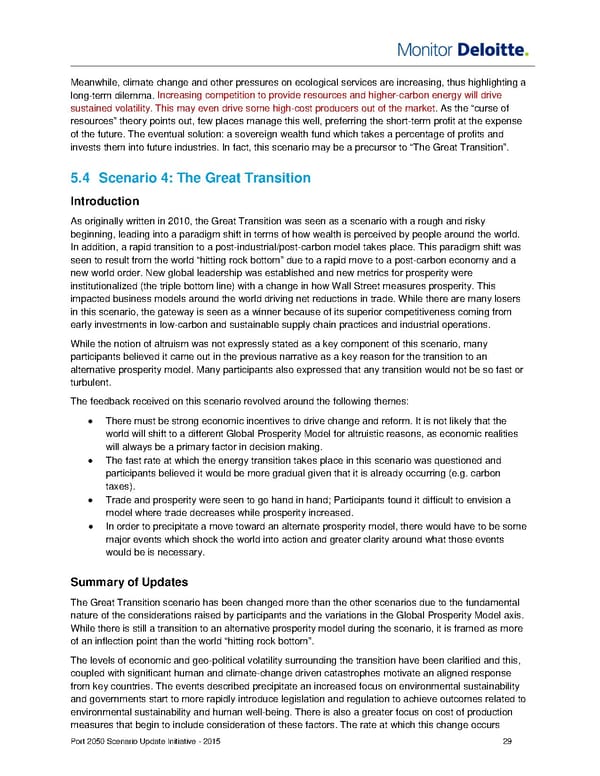Meanwhile, climate change and other pressures on ecological services are increasing, thus highlighting a long-term dilemma. Increasing competition to provide resources and higher-carbon energy will drive sustained volatility. This may even drive some high-cost producers out of the market. As the “curse of resources” theory points out, few places manage this well, preferring the short-term profit at the expense of the future. The eventual solution: a sovereign wealth fund which takes a percentage of profits and invests them into future industries. In fact, this scenario may be a precursor to “The Great Transition”. 5.4 Scenario 4: The Great Transition Introduction As originally written in 2010, the Great Transition was seen as a scenario with a rough and risky beginning, leading into a paradigm shift in terms of how wealth is perceived by people around the world. In addition, a rapid transition to a post-industrial/post-carbon model takes place. This paradigm shift was seen to result from the world “hitting rock bottom” due to a rapid move to a post-carbon economy and a new world order. New global leadership was established and new metrics for prosperity were institutionalized (the triple bottom line) with a change in how Wall Street measures prosperity. This impacted business models around the world driving net reductions in trade. While there are many losers in this scenario, the gateway is seen as a winner because of its superior competitiveness coming from early investments in low-carbon and sustainable supply chain practices and industrial operations. While the notion of altruism was not expressly stated as a key component of this scenario, many participants believed it came out in the previous narrative as a key reason for the transition to an alternative prosperity model. Many participants also expressed that any transition would not be so fast or turbulent. The feedback received on this scenario revolved around the following themes: • There must be strong economic incentives to drive change and reform. It is not likely that the world will shift to a different Global Prosperity Model for altruistic reasons, as economic realities will always be a primary factor in decision making. • The fast rate at which the energy transition takes place in this scenario was questioned and participants believed it would be more gradual given that it is already occurring (e.g. carbon taxes). • Trade and prosperity were seen to go hand in hand; Participants found it difficult to envision a model where trade decreases while prosperity increased. • In order to precipitate a move toward an alternate prosperity model, there would have to be some major events which shock the world into action and greater clarity around what those events would be is necessary. Summary of Updates The Great Transition scenario has been changed more than the other scenarios due to the fundamental nature of the considerations raised by participants and the variations in the Global Prosperity Model axis. While there is still a transition to an alternative prosperity model during the scenario, it is framed as more of an inflection point than the world “hitting rock bottom”. The levels of economic and geo-political volatility surrounding the transition have been clarified and this, coupled with significant human and climate-change driven catastrophes motivate an aligned response from key countries. The events described precipitate an increased focus on environmental sustainability and governments start to more rapidly introduce legislation and regulation to achieve outcomes related to environmental sustainability and human well-being. There is also a greater focus on cost of production measures that begin to include consideration of these factors. The rate at which this change occurs Port 2050 Scenario Update Initiative - 2015 29
 Monitor Deloitte - Final Report Page 30 Page 32
Monitor Deloitte - Final Report Page 30 Page 32